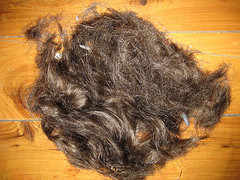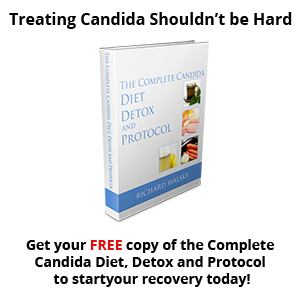 During a Candida infestation, hair loss is often a worrisome and emotional problem for both men and women. Over the years, I’ve received many messages and letters from Candida sufferers who were desperate for answers to their questions about losing their hair during their Candida infestation. Many of them have used statements such as, “This cannot possibly be a coincidence; losing my hair started right after I realized that I had a terrible health issue in my body, I just didn’t know what it was. Why is the Candida making my hair fall out?”
During a Candida infestation, hair loss is often a worrisome and emotional problem for both men and women. Over the years, I’ve received many messages and letters from Candida sufferers who were desperate for answers to their questions about losing their hair during their Candida infestation. Many of them have used statements such as, “This cannot possibly be a coincidence; losing my hair started right after I realized that I had a terrible health issue in my body, I just didn’t know what it was. Why is the Candida making my hair fall out?”
I remember one young lady in particular telling me, “Losing my hair is the worst part of this entire yeast problem! Please help me before it all falls out!”
If you’ve contracted a Candida infestation, and afterwards you began to suffer from premature hair loss or other scalp issues which can include dandruff, itching, or extremely oily scalp, these are likely being indirectly caused by the fact that you also have a Candida infestation in your body.
The Environment; Perfect
First, let’s look at why you have a Candida albicans overgrowth in your body. Chances are that your problems started after one or more rounds of antibiotics or perhaps many rounds over the past 10 to 20 years. Perhaps you were not even aware that a problem was developing, because an actual overgrowth of Candida will often take many years to reach the infestation stage.
Let’s say that someone has had a round of antibiotics every few years for the past 10 to 20 years. Then, a few weeks ago they had to take another round for whatever reason, and suddenly, for no apparent reason, they began to experience several symptoms of a Candida overgrowth. Of course, they had no idea what was causing these odd symptoms, and often it will take several months or even years longer to realize that the round of antibiotics and the symptoms are related; but unfortunately they are.
As you can see, one round of antibiotics was not the single cause of the fungal Candida infesting their body, but the infection actually took many, many years to develop before something triggered the yeast which then begin to turn into a fungal form causing physical signs of the building infestation to appear. In the end, there was probably a combination of situations which allowed the overgrowth of fungal Candida albicans.
The Environment
Before the population of Candida can reach the numbers of an infestation in the body, the environment of the intestines would need to be changed to a condition which favored the benign Candida yeast. This change would allow the fungal gene to be turned on and the benign Candida would turn into its fungal form.
By destroying billions of beneficial, acid-producing bacteria, several rounds of antibiotics would help tremendously in changing the normally acidic environment of the intestines into an alkaline pH environment suitable for the yeast. With fewer and fewer beneficial bacteria producing the acid needed to protect the intestines, the yeast can continue to easily change into their fungal form and began infesting the body. Specific foods would need to be supplied on a daily basis for the yeast, and foods that would feed the beneficial bacteria would be at a minimum.
What Food?
Foods that would feed the benign as well as the fungal form of yeast would be plentiful amounts of simple carbohydrates and foods which contain starch such as potatoes, corn, rice, carrots, pasta and all the other products which use these foods during their manufacturing process. Also foods containing sugar and wheat flour (cereal, bread, pizza, etc.) as well as the fruits containing fructose. These foods are the perfect diet for setting off a waiting population of benign yeast and establishing a fungal Candida albicans infestation in the human body.
Ready and Waiting
So now, with your sugar-filled, high carbohydrate diet, you’ve secured a safe environment for allowing the fungal form of Candida to infest your body. The last few doses of the antibiotic have been taken and the benign yeast are rapidly changing to their fungal form and multiplying in your intestines. And then you experience the first of many symptoms to come, and you’re wondering what on earth is wrong with you.
Candida and What Else?
When the environment is perfect for the Candida albicans to infest your body, it’s also perfect for other pathogens to make your body their home. One of the many pathogens that may be inhabiting your body at the same time as the Candida are called Malassezia which is a fungus that lives on the scalp of many healthy humans without resulting problems most of the time. However, if the circumstances are just right, the population of this fungus can grow out of control the same as the Candida can. The overgrowth can cause an irritation to the scalp therefore causing access skin cells to grow on the scalp. These access skin cells will die and clump together with oil from the scalp hair, and the results are nearly identical to Seborrheic Dermatitis which would usually cause severe itching of the scalp and dandruff.
Candida, Hormones, and your Hair
Candida overgrowth, when not immediately treated correctly will more times than not affect the body’s hormones, the result of which is usually hypothyroidism. The condition, hypothyroidism, causes a decrease in general circulation which will lead to damaging the follicles of the hair. If you have this problem, you can have your thyroid checked by a physician for the thyroid hormones, triiodothyronine (T 3) and thyroxine (T 4). Sometimes taking thyroid medication is necessary for a while during a Candida infestation.
Ending the Symptoms Including Hair Loss
Basically, the level of hormones will be corrected once you have sufficiently decreased the population of your Candida infestation. In order to do this, the correct diet and supplement protocol will have to be followed until the symptoms have disappeared.
If you’re looking for a diet and supplement protocol which works, this site has one which has been used with success by many people over the past few years.
Image credit angusf @ creative commons – http://www.flickr.com/photos/angusf/
The links that are on the Candida Diet and Protocol as well as the links in these articles were placed there by the owners of this website, Probacto.com. Any and all payments that are received via the links as well as all profits from the sales of products marketed on this website are received by the owners of Probacto.com.
Signed by: Site Administrator



